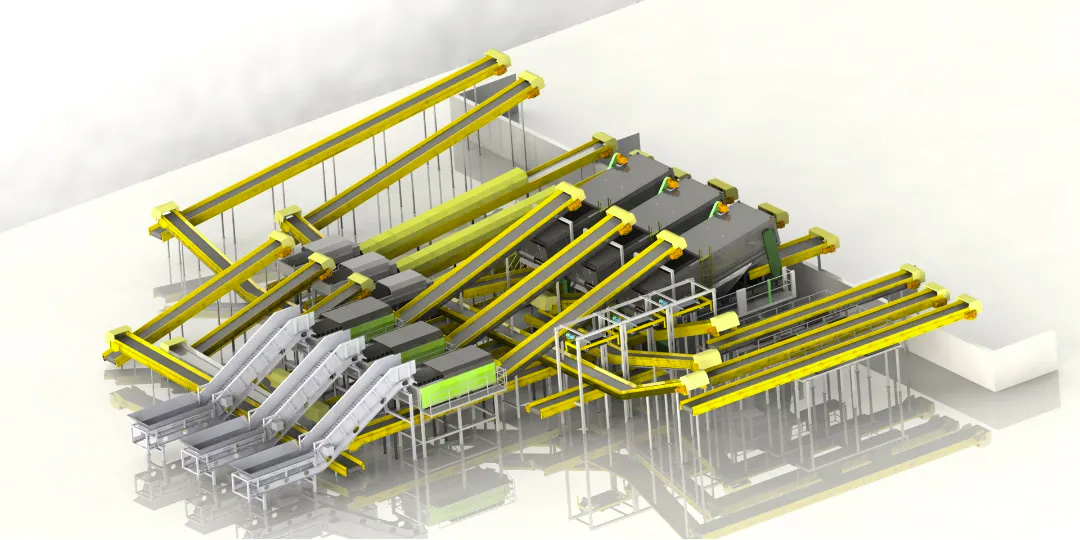 Time:2025-03-31
Time:2025-03-31
 Source:青绿环境
Source:青绿环境
In modern society, waste management has become an increasingly severe environmental issue, and waste sorting equipment is gradually emerging as a key force in efficiently solving this problem.

I. The Challenge of Waste Management and the Emergence of Sorting Equipment
With the development of the economy and the acceleration of urbanization, the volume of waste generated has surged dramatically, and its composition has become increasingly complex. From various packaging materials and discarded furniture in daily life to waste and residues in industrial production, the diverse types of waste pose numerous challenges to waste management. One of the prominent difficulties is the soaring cost of waste treatment, which includes the collection, transportation, storage, and final disposal of waste, all of which consume substantial human, material, and financial resources. For instance, some large cities need to deploy thousands of waste collection vehicles daily, incurring huge transportation costs. Moreover, traditional waste treatment methods such as landfilling and incineration carry the risk of secondary pollution, which can severely contaminate soil, water sources, and air, threatening the ecological environment and human health.
Waste sorting equipment has emerged as a solution to these challenges. Based on advanced identification technologies and mechanical design, it can effectively separate waste of different types and materials. For example, infrared identification technology can distinguish recyclables such as plastics, paper, and metals, while magnetic separators can accurately pick out ferromagnetic metals, facilitating subsequent treatment processes. This significantly reduces the workload and error rate of manual sorting and improves the overall efficiency of waste management.
II. Performance Evaluation Indicators of Waste Sorting Equipment
The main performance evaluation indicators of waste sorting equipment are crucial. Sorting efficiency is one of the keys, which includes the amount of waste sorted per hour and the accuracy rate of sorting. For example, an efficient waste sorting machine can process tens of tons of waste per hour with a sorting accuracy rate of over 95%. This means that a large volume of waste can be processed in a short time, and the vast majority of waste can be correctly classified. The reliability of the equipment is also important, with low failure rates and long service life being important criteria for evaluating its quality. A high - quality sorting device can operate stably for several or even more than ten years under normal use and maintenance, reducing the costs and time wasted on equipment repair and replacement. Adaptability is equally important. The equipment must be able to adapt to different types of waste and environmental conditions. For instance, when dealing with damp waste, the relevant parts of the equipment should be rust - and corrosion - resistant. When facing waste of different shapes and sizes, the sorting mechanism of the equipment should be able to adjust and adapt flexibly to ensure the smooth progress of the sorting work.
Take a large - scale waste - treatment center as an example. After introducing an advanced waste - sorting system, its daily processing capacity increased from 1,000 tons to 1,500 tons. The sorting accuracy rate also rose from 80% to 96%, while the equipment failure rate was significantly reduced. This effectively improved the efficiency and quality of the entire waste - treatment process and lowered operating costs.
III. Application Strategies for Waste Sorting Equipment in Different Scenarios
In municipal solid waste treatment centers, where the volume and variety of waste are large, large - scale and high - performance waste - sorting equipment is required. These machines typically combine multiple sorting functions, such as mechanical screening, optical recognition, and magnetic separation, to quickly and efficiently sort waste into several major categories: recyclables, hazardous waste, food waste, and other waste. The layout of the equipment should be rationally planned, with different sorting areas set up according to the waste - treatment process to ensure the smooth flow of waste between various stages.
In industrial waste - treatment plants, the composition of waste is relatively uniform but the volume is large, and there may be some special hazardous substances or large - scale solid waste. Therefore, appropriate waste - sorting equipment should be selected based on the specific type of industrial waste. For example, strong magnetic separators can be used for industrial waste containing metal shavings, and hydraulic crushing combined with mechanical gripping equipment can be used for preliminary treatment of large - scale solid waste. In terms of layout, the load - bearing capacity and operating space of the equipment should be considered to facilitate the operation and maintenance of heavy machinery.
Small - scale community waste - treatment stations focus on the miniaturization, ease of operation, and environmental friendliness of equipment. Since the volume of waste generated in communities is relatively small, small - scale, manual or semi - automatic waste - sorting equipment can be chosen, such as simple waste - sorting racks and small - scale magnetic separators, which are convenient for residents to use and manage. At the same time, the noise of the equipment should be kept at a low level to avoid disturbing the lives of community residents.
IV. Maintenance and Care of Waste Sorting Equipment
Daily maintenance and care of waste sorting equipment are crucial. Cleaning is fundamental. After each day's operation, the residual waste on the surface and inside of the equipment should be cleaned to prevent corrosion of equipment parts and blockage of sorting channels. Lubrication should not be overlooked. Regular lubrication of key parts such as transmission components and bearings can reduce wear and friction during equipment operation, extending the service life of the equipment. In terms of component replacement, worn - out parts such as conveyor belts, sorting claws, and filters should be replaced in a timely manner according to the usage and wear conditions of the equipment to ensure that the equipment is always in good operating condition.
Regular maintenance and care can not only extend the service life of equipment but also ensure the stability of its performance. For example, regular inspection and calibration of key components can maintain a high level of sorting accuracy. When encountering common faults such as equipment jamming or abnormal noise, troubleshooting and response can be carried out by checking the power supply, clearing blockages, and adjusting the position of components. If the equipment has electrical faults or complex mechanical problems, professional maintenance personnel should be contacted in a timely manner to avoid greater damage caused by self - disassembly.
V. The Impact and Optimization of Waste Sorting Equipment on Waste Management Systems
Waste sorting equipment holds a significant position in the entire waste - management system. It is the key link connecting waste collection and subsequent treatment processes. Through efficient sorting, recyclables can enter the recycling system, reducing the exploitation of virgin resources. Hazardous waste can be properly treated to minimize environmental and health risks. Food waste can be composted or processed through anaerobic fermentation to produce organic fertilizers or energy.
To further enhance the efficiency and stability of the entire waste - management system, waste - sorting equipment should work in synergy with other waste - treatment equipment. For example, when used in combination with waste compactors, sorted waste can be compressed to reduce transportation and storage costs. When used in conjunction with incinerators, it ensures that the waste to be incinerated meets the required composition, improving energy - recovery efficiency. Meanwhile, the optimization and upgrading of waste - sorting equipment can also drive improvements in upstream and downstream processes. For example, it can encourage waste - collection companies to focus more on the quality of waste sorting and promote the development of waste - treatment technology in a more efficient and environmentally friendly direction.
Conclusion
Waste sorting equipment, as an important tool in modern waste management, plays an irreplaceable role in solving waste - management problems with its efficient and accurate sorting capabilities. By continuously optimizing equipment performance, applying it reasonably, and maintaining it properly, as well as strengthening cooperation with other treatment processes, we can hope to build a more scientific and efficient waste - management system. This will help achieve the goals of waste reduction, resource recovery, and harmless treatment, making a greater contribution to environmental protection and sustainable development.













 Prev
Prev











